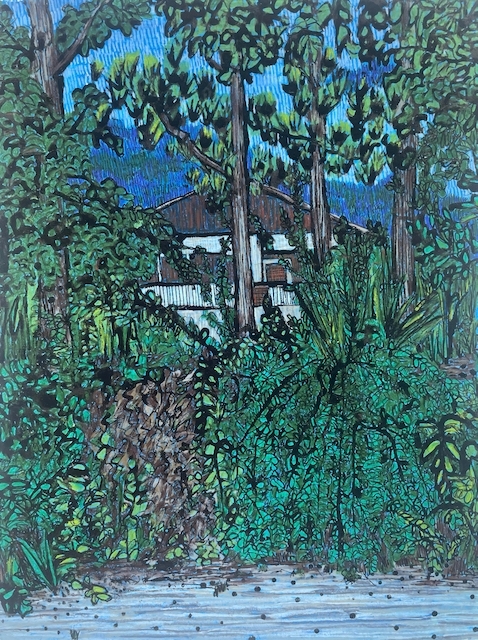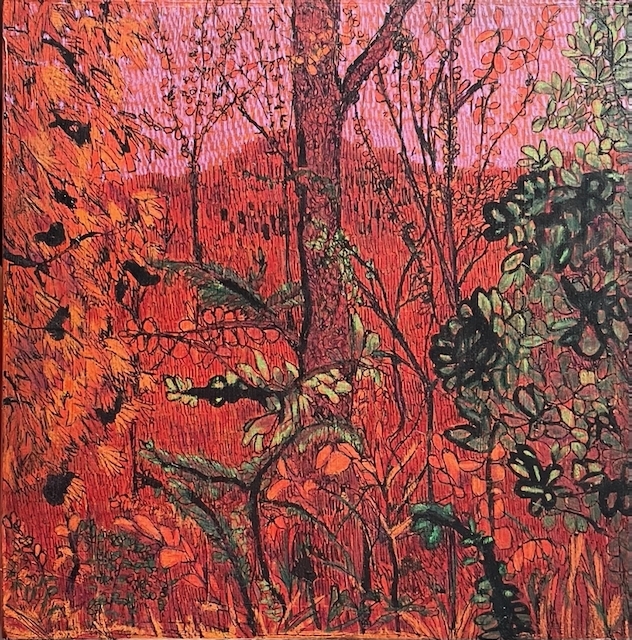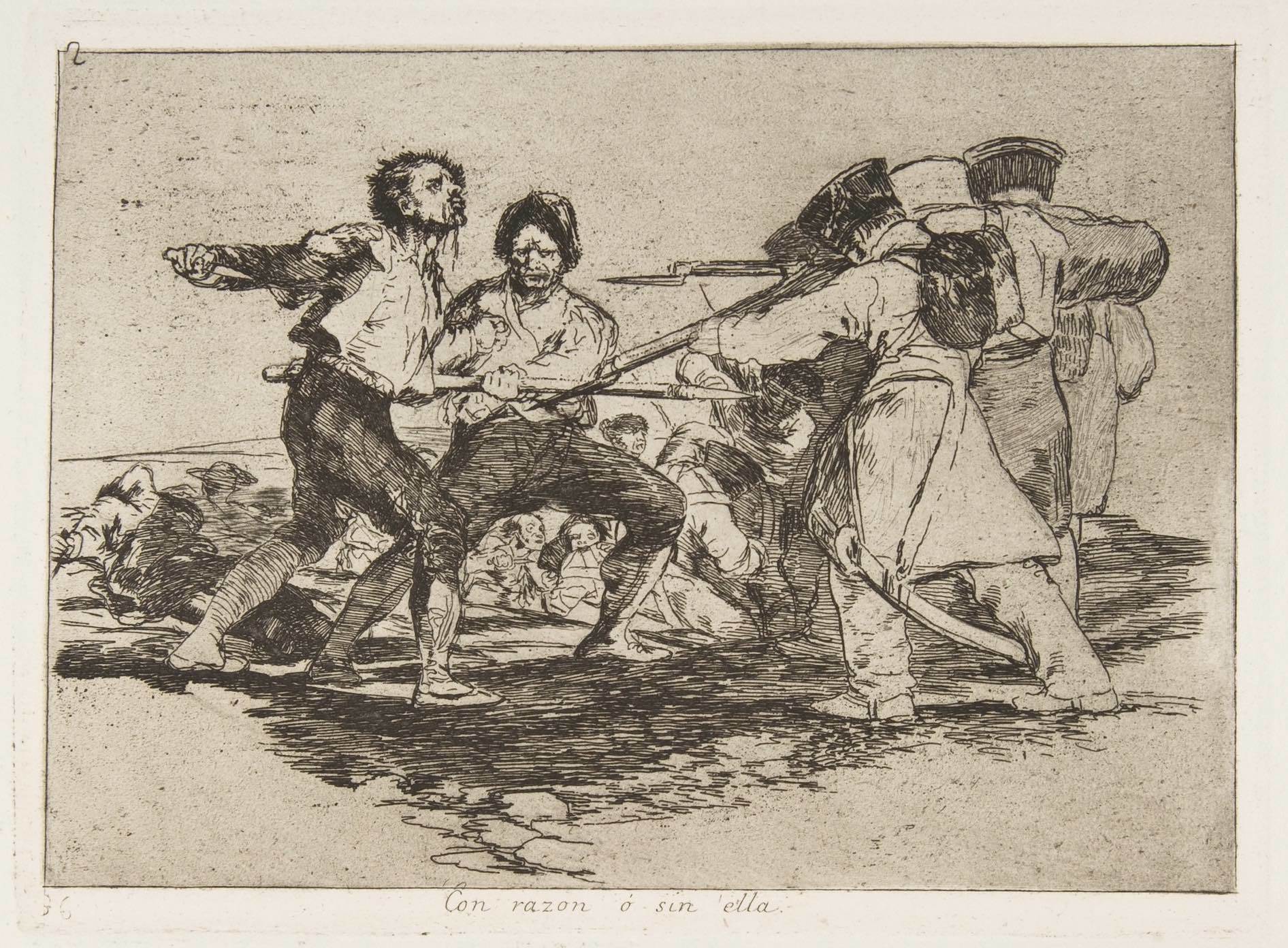Contributors: Makoto Fujimura, Jared Stacy, and Grace Parker
Heading image: Goya, Francisco. Plate 2 from “The Disasters of War” (Los Desastres de la Guerra): ‘Rightly or wrongly’ (Con razon ó sin Ella). Public Domain.
A Note from IAMCultureCare
Happy New Year from IAMCultureCare!
The few transition weeks around the end of December and beginning of January are often marked by a strange period of restless reflection. We emerge from post-holiday lethargy to face a new year that seems to always arrive far quicker than anticipated and that brings with it both new joys and worries. I write this in the midst of festive (if hectic) holiday travels between Seattle, Chicago, and back to New York. I also write in the midst of the aftermath of the devastating earthquake and fires in Japan that will affect many in the months and years ahead, including traditional artisans and craftspeople. I was recently reminded by one of the Academy Kintsugi facilitators that Wajima, Ishikawa (the earthquake’s epicenter) is the main source for the precious Urushi sap that forms the basis of Japanese lacquerware and Kintsugi. Like Kintsugi, may these (literal) fractures be the beginning of something new and beautiful.
As has become somewhat of a theme lately, this month’s newsletter seeks to press into the tensions of our moment. I encourage you to take time this week to read this newsletter slowly, share it with a friend (perhaps the beginning of your own local Culture Care community?), and ponder this January offering. IAMCultureCare’s founder Makoto Fujimura reflects on Culture Care and the role of art and artists to mend the fractures of false binaries and culture war divisions. Theologian and guest contributor Jared Stacy (University of Aberdeen) examines how Culture Care subversively does this in the first of a three-part essay series on the “Ethos of Culture Care”. Jared will write on Time, Substance, and Presence in the months ahead. Finally, artist Grace Parker searches for beauty in the fragments and fractures with two stunning works, a great example of living according to Jared Stacy’s “kairic” time. Also in this issue, an update from IAMCC partner Embers International, plus more details regarding Makoto Fujimura’s upcoming exhibits/speaking engagements in California and South Carolina.
As always, continue to connect with us, including for opportunities to contribute art, poetry, essay, reflection, music, Culture Care news, or anything else to the newsletter. You can email jacob@internationalartsmovement.org for more information. We have an exciting slate of contributions to look out for in the months ahead from readers like YOU, so please consider sharing something with our community.
Jacob Beaird, Editor
A Note from Makoto Fujimura, Founder of IAMCultureCare
Dear Culture Care Communities:
In the days of extreme polarization, divisions and even atrocious wars, we are forced to think “which side am I on?” In recent days, such “choosing of sides” means that we act aggressively on social media or on the streets to display our loyalties. We judge others who may not be as enthusiastic of our positions. And we even destroy artifacts that oppose our views as an act of our outrage toward injustice.
As we have learned in our Culture Care journey, we need to be aware of the temptation of our hearts to create false binaries in fear, to create a scapegoat, an idol “enemy” at the heart of all that is wrong with the world. Such temptation is pervasive, but we need to also realize that these false binaries can create poisonous culture war rhetoric which can lead to real wars, eliminating generative possibilities from the future.
In culture wars, we are often defined by what we oppose, rather than what we stand for. In culture care, we proactively advocate and define what is true, good and beautiful, despite what we see lacking in the world. In that act of faith, we create and imagine the future, as I often note, “standing on the ashes of Ground Zero”, creating a generative path of making. Culture Care is a path toward asking the impossible question: “even in the light of facing my devastation, how do I begin to love my enemies?”
The new year will also bring with it our resolutions and a “turning over the page” of our past to renew our commitments. What if (as our Advent season podcast Liturgies for Uncertainty suggests) we pause and reflect upon our own divided and conflicted hearts first, and live intentionally in the mysteries of unknowing? What if we pause also in our judgment and ask a deeper question toward both sides of the binary to allow complexities to co-exist.
We realize that is hard to do, perhaps even impossible. Yet art is one sure path to move beyond the false binaries and categories of allegiances that we are often asked to follow. Of course, such a path may require courage to “turn over tables” (Matthew 21:12 – 13) of established notions, and sacrifice our own safety to advocate for others. We, as artists, are first called to create into such complexity, to “mend to make New” as our Kintsugi journey requires of us.
May 2024 be such a year of generative possibilities, a year that posits for the next generation the generosity given in each moment, a moment of pause, a moment of possibilities, and perhaps even a gesture of hope.
From the Estuary,
Mako Fujimura — January 2024
Essay Feature: Ethos of Culture Care (Time)
By Jared Stacy
Over the course of this short three part series, I want to reflect on three elements I think must be found in a culture care ethos. These elements are time, substance, and presence.
In general, I’m convinced most talk about ethos or “the good” is ultimately talk about God. That is to say, with Hans Ulrich — a Christian ethos is one that sees God’s salvation as the ultimate, decisive, and determinative intervention in our history, and our estimation(s) of good and evil. This deliverance makes such a thing as “culture care” possible because it recognizes culture as created, not ultimate.
And yet, an ethos of culture care is good — I believe — for Christians and non-Christians alike. That’s because an ethos of culture care, beneath the banner of a Christian ethos, recognizes culture for what it is: not ultimate, but a human product, yet something that involves all of us.
Christians ought to admit (indeed, confess) that we have not lived from this state of solidarity. A solidarity that recognizes culture as something we all cultivate, together. We have opted for culture war, not culture care. But like Joseph Campbell once said, “if you want to change the world, change the metaphor.” And if Christians seek to contribute to culture, we have to opt for better talk, better metaphors, about it.
And that’s what an ethos of culture care does. It confronts culture war, the prevailing metaphor for Christian engagement with “culture”, and its ethos of domination and violence, with an ethos of cultivation and forbearance.
Cultivation and forbearance — in an agricultural sense — is bound to time, to the four seasons. Like planting, an ethos of culture care must think of time in a particularly unique way, too. This comes from Scripture itself.
In the Bible, there is standard, quantitative time, chronos, of hours and seconds, and subversive and qualitative time, what the Greeks called kairos. The difference between chronic time and kairic time is the difference between looking at your Apple Watch to check “the time” for a meeting or knowing instinctively the exact moment you need to hop on your surf board to catch the wave.
An ethos of culture care is attuned to God’s kairos. This ethos endlessly seizes the now, the present, seeing it as full of possibilities and potential, caring for culture as a creature, like ourselves, reflecting our Creator. It is filled with an honest gritty hope, that creates — as Albert Camus observed — for all.
An ethos of culture care tunes itself to God’s kairos—to the decisive moment that is the present, made decisive by God’s presence. It cultivates and creates amidst the material of human culture, acts of witness to God’s reconciliation, which Jesus declares as gospel, as “good news.”
An ethos of culture care, in a word, seizes the now of kairic time, it trades on this time in God to cultivate, to sow, to build, to create. This kairic time is what Jesus had in mind in Mark’s gospel where he announced the Kingdom, “the time (kairos) is fulfilled, the kingdom of heaven is at hand.”
Seizing the now of kairic time acts on faith in a future coming towards us. St. Paul picked up this element of time in his letter to the early Christians in Galatia, where he instructed them, “As you have the kairos, do good to all, especially to those who are of the household of faith.” St. Paul wasn’t inviting the church in Galatia to discriminate and elevate Christian care over non-Christian care, as some readings of this text try to defend. No. He was highlighting the great weight of responsibility the church-community bears as witnesses to God’s kairos in Jesus: an invitation to all, but an invitation that only becomes intelligible through an ethos of culture care that begins with the church and extends to all, with solidarity and hospitality.
Jared Stacy is an American ethicist and theologian residing at the University of Aberdeen in Scotland as a PhD candidate. His research focuses on political extremisms and political theology. You can find him on platforms like Substack, Instagram, and X.
Art Feature: "In the thick of it" & "Violet"

In the thick of it copyright © Grace Parker 2023
Sumi ink, gouache, and colored pencil on paper

Violet copyright © Grace Parker 2023
Sumi ink, gouache, and colored pencil on wood panel.
By Grace Parker
This ongoing series of mixed media pieces are my “illuminations of nature’s delight” — an effort to find glimpses of Heaven and goodness in spite of the fragmented world we live in. By using a bamboo stick dipped in Sumi ink for much of the drawing, I am practicing letting go of control of the mark making, which reflects the very essence of nature. With bright and captivating colors in the background and foreground, I illuminate the beauty and glory of the Creator.
I’m based in Chattanooga, TN, and I was born and raised in Nagoya, Japan. Although I am formally trained as a graphic designer, I find immense joy in exploring various mediums to create, design, and document beauty around me. Art is my form of worship — it humbles me, teaches me, and brings me joy.
Partner Spotlight: Embers International
IAMCC’s partner organization, Embers International, recently released a year-end update video from Embers’ CEO Haejin Shim Fujimura. Watch that to hear about what they have been doing in 2023 and plans for 2024, check out Haejin’s article in Comment Magazine about how Embers provides hope to those trapped in human trafficking, or listen to this interview about how you can be involved in justice work through Embers’ Artist or Community Advocate programs.
Sahasee Embers Cultural Center (Sahasee means “courageous” in Hindi) is a haven serving women and children living in red-light districts in India. Once a brothel, it now serves the community as a daycare center, emergency shelter, community center, legal aid clinic, and education center. For children born into brothels, Sahasee Embers is a safe place to rest, play, and learn, and for women, the center provides a caring community. Embers children have a chance to experience a future filled with freedom and hope, and through our various programs, families have a chance to break free from generational violence and bondage. As the name Sahasee Embers implies, the Embers team sees the women and children they serve as courageous little flames.
Culture Care News & Events
- “My Bright Abyss: Paintings & Prints” Makoto Fujimura Exhibit at Bradford Gallery — Nashville, TN, Now — March 31. The exhibit is open on Sunday mornings and for special events, as well as group tours. Contact the St. George’s Episcopal Church office to find out how/when to visit.
- “Mysterion” Makoto Fujimura Exhibit at The Galleries at First Pres — Greenville, SC, Now — July 25. Mini-retrospective of Makoto Fujimura’s works. Fujimura will be speaking at the Mystery of Beauty Conference held at First Presbyterian Church on March 1, 2024. The conference celebrates the beauty to be found daily all around us as well as the ways that we can use artistry and even our very lives to display beauty particularly. Featuring internationally renowned artist, author, and speaker Makoto Fujimura (among other contributors including Dr. Wesley Vander Lugt, professor of art and theology at Gordon-Conwell, Abilene Music, and Greenville artist, Caroline Riddle), this half-day arts conference provides opportunities both to engage with conversations of beauty and to encounter it.
- “Water Flames” Makoto Fujimura Exhibit at Pepperdine University’s Frederick R. Weisman Museum of Art — Malibu, CA, Jan 13 — March 31. This exhibit brings together a number of Fujimura’s major paintings of the last 20 years, focusing on the poetic paradox between the elements of water and fire, which symbolize, in Fujimura’s words, art’s power to “[turn] the flames of destruction into the flames of sanctification.” The artist will speak at Pepperdine’s Stauffer Chapel on Thursday, 1⁄18 at 5:30 PM along with a film screening and presentation from his wife and CEO of Embers International, Haejin Shim Fujimura, on their join work of Justice & Beauty. The Opening Celebration is on Saturday, 1⁄20 from 2 – 5 PM at the Weisman Museum. Please RSVP online for the opening.
- The Overseas Ministries Study Center at Princeton Theological Seminary is accepting applications for their 2024 – 2025 Artist in Residence Program: “Integral to our mission of amplifying the often silent or silenced voices of the world Christian movement, each year the executive director invites one artist in residence from the majority world (Asia, Africa, Latin America, or Oceania) to participate in OMSC@PTS’s Residential Study Program for a full academic year (September-May). While pursuing their work, the artist in residence participates in OMSC@PTS programs and seminary community life. The artist will have opportunities to share their work at our Annual Gala, month-long art exhibit, in classrooms, and in other venues on campus and beyond. Airfare, housing, monthly stipend, and studio space are provided.” Check out the OMSC site above for more information.
Do you have a news item or upcoming culture care event? Consider sharing it with us for a feature here in the newsletter! Email jacob@internationalartsmovement.org.
Web Links
- Resources for pastors to help foster peace amid political polarization.
- Poet Christian Wiman recently wrote a new book: Zero at the Bone: Fifty Entries Against Despair. Read an excerpt in Plough Magazine, and if that doesn’t whet your appetite enough there are great pieces from Ecstasis (an interview) and the New Yorker (a review).
- A preview of four great poets translated to English for the first time.
- Matthew Milliner writes a four-part Advent series for Comment Magazine on the Virgin Mary.
- A fun virtual tour of the new Africa & Byzantium exhibit at the MET Cloisters.
- Humanities professor at Baylor University Alan Jacobs writes on George MacDonald and myth-making, and makes implicit reference to Kintsugi.
- A follow-up read to Jared Stacy’s essay above, a recently highlighted piece via The Rabbit Room on Wendell Berry’s novel Jayber Crow. Jake Meador explores what it might mean to love and live well (according to kairic time).
Heading image: Goya, Francisco. Plate 2 from “The Disasters of War” (Los Desastres de la Guerra): ‘Rightly or wrongly’ (Con razon ó sin Ella). Etching. 1810. Metropolitan Museum of Art, https://www.metmuseum.org/art/collection/search/371595 (accessed January 9, 2024). Public Domain.
